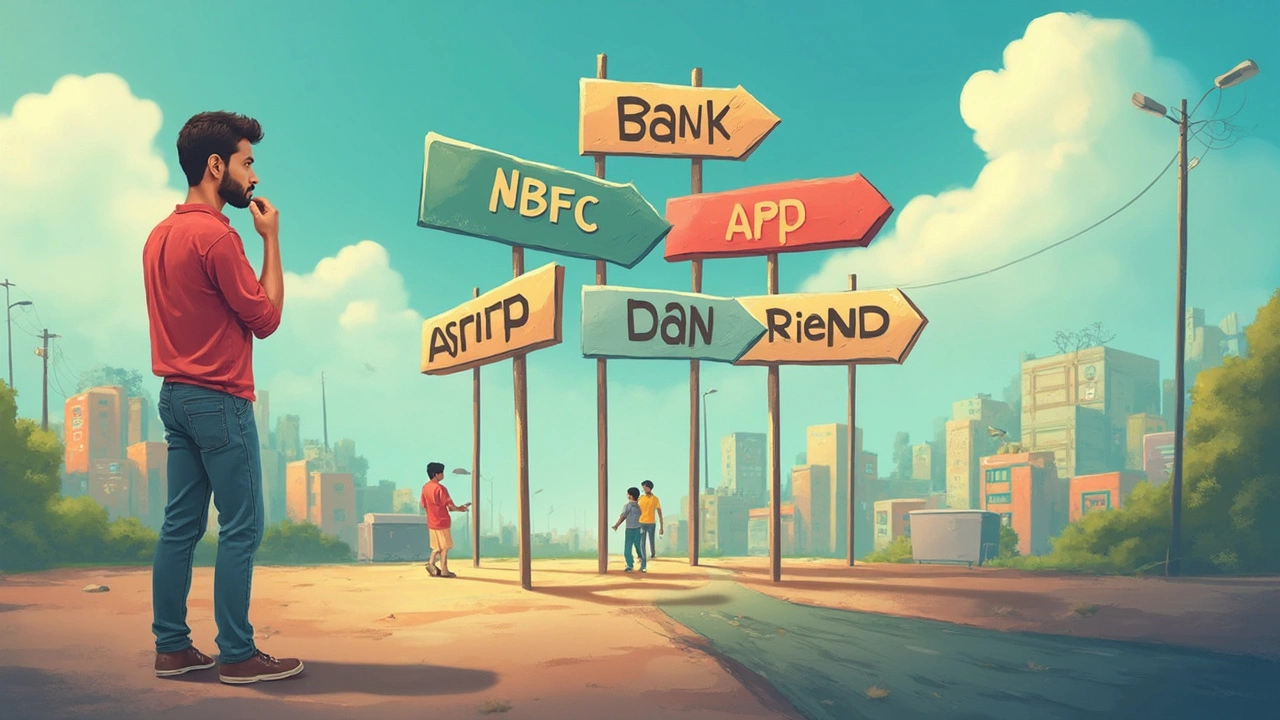You’d think that with how quickly cash-crunches pop up, getting a personal loan would be as painless as ordering a pizza. But you know what? It’s an absolute maze out there. For every legit place, you’ll stumble into a handful of traps—hidden charges, scam apps, those “instant approval” ads hiding nasty interest rates or even fraud. A right move gives you relief, a wrong one can mess up your credit for years. Just last year, over 1,500 fake loan apps were delisted by Indian authorities. That number alone should be a wake-up call.
Where Is It Actually Safe to Borrow Money?
Let’s talk straight: safety is about more than having an RBI logo slapped on a website. It’s knowing your lender won’t suddenly ghost you, slam you with hidden penalties, or sell your data to the highest bidder. People often jump into the arms of whoever promises fast cash—big mistake. The real secure choices come down to a few key places: regulated banks, authorized NBFCs (Non-Banking Financial Companies), and popular digital channels tied to those institutions. I’d never touch an unknown app or moneylender, not after hearing stories from friends in Mumbai who fell into those payday-style traps—and I’m not just being dramatic. When a friend of mine, Anil, grabbed a quick loan off some sketchy app, he landed in collection hell: abusive calls, inflated dues, data theft. That’s just not a risk worth taking.
Banks are the most traditional route. Think HDFC, SBI, ICICI and their ilk. You get predictable terms, competitive rates, and government regulation which, let’s face it, is the best insurance policy in India’s wild loan market. There’s also NBFCs like Bajaj Finserv, Tata Capital, or Fullerton—these are perfect if your credit profile isn’t squeaky clean but you still want transparency and fast disbursal. Now, there’s a third route picking up serious speed: digital loan platforms that partner with banks and NBFCs, like Paytm, Cred, or Navi. These guys aren’t lenders themselves, but they connect you with the biggies, handle your paperwork online, and can dish out funds in a couple of hours. Of course, you’ve got to double-check they’re RBI-approved; otherwise, it’s like leaving your wallet with a stranger.
Check for some must-have signs: a registered NBFC licence number on their site, RBI registration (there’s a public directory), clear interest rates spelled out up front, and no demand for random fees before approval. If it’s all hidden or feels rushed—run. Want a sanity test? Google the lender’s name plus the word “scam”—what pops up? A trustworthy lender won’t show up on news reports about police raids. It’s that simple. I’ve helped Maya, my wife, compare offers recently and we came up with this quick checklist—everyplace that didn’t tick all our boxes, got cut from the shortlist right away.

Spotting Red Flags & Avoiding Dodgy Lenders
Safety with personal loans hinges on picking the right partner—toxic ones will hollow out your finances and dump you with harassment. Fake apps, fly-by-night agencies, even some lesser-known fintechs—these can get downright dangerous. The Mumbai cyber cell receives thousands of complaints about loan app blackmail and privacy abuse every quarter. Here’s how they usually trap people: fast cash for almost zero paperwork, but suddenly they demand access to your contacts, your photos, even your messages. Miss a payment by a day and those same contacts start getting threatening calls. The privacy invasion is just stunning. There was a report not too long ago: a scam app operator made around ₹100 crore in a single year, purely by trapping desperate borrowers with high fees and collecting data. Totally legal-looking at first glance—until you see the fine print or land on the wrong side of their app permissions.
The first defense? Download apps only from the official Google Play Store or Apple Store. Not even kidding: the majority of scam loan apps come from APK files people send around or download off third-party sites. Then, check for transparent processes—the best lenders have neat, simple steps, plain-English disclosures, live customer support numbers, and they never “require” you to give up your gallery or contact list to get a loan. If an app or a so-called digital lender won’t tell you their physical office location or registration status, just ditch it immediately.
You also want to look out for pressure tactics: offers that claim to “expire in two hours,” high processing fees upfront, or guaranteed approvals despite poor credit. Here’s something few people know: real lenders always do a credit check, they care about bureaucracy. Those who promise zero checks? Usually up to no good. If you ever feel threatened or harassed, you can actually file a complaint directly with the RBI’s Sachet portal (it’s pretty user-friendly) or go to your local police—do not let embarrassment stop you. Data theft is an actual crime, not just a minor annoyance.
| Provider Type | RBI Approved? | Typical Interest Rates (per annum) | Average Processing Time | Data Privacy |
|---|---|---|---|---|
| Banks (e.g. SBI, HDFC) | Yes | 10% - 20% | 1–3 days | High |
| Authorized NBFCs | Yes | 12% - 27% | Few hours – 2 days | High |
| Popular Online Platforms (Paytm, Cred, Navi) | Partnered with Banks/NBFCs | 11% - 28% | Minutes – 1 day | High (when RBI-regulated partners involved) |
| Unregulated Apps | No | 35% and above | Instant (with risks) | Very Low / No Protection |
So, if someone promises an unsecured loan with zero questions, lightning speed, and almost no documents—pause and ask yourself, “What’s their catch?” Because the safest place to get a personal loan, really, is where your data, money, and legal rights are protected every step of the way. Strong, established lenders are dull for a reason: they’re reliable and regulated, the opposite of a scammer’s playground.

Tips for Taking a Secure Personal Loan and Protecting Yourself
Let’s get tactical—there are ways to play it safe and smart, even in this shark-infested loan market. Maybe you’re planning a destination wedding, urgent home repairs, or need to cover a family emergency. Here’s how to make sure you’re never the star of a cautionary tale:
- Plan amounts carefully: Figure out how much you need—don’t borrow extra “just in case.” More borrowed means more to repay with interest.
- Compare at least three offers from safest place to get a personal loan options: bank, NBFC, and a top digital platform. Use comparison sites you trust—don’t rely on WhatsApp forwards or “friend of a friend” recommendations.
- Ask about extra fees: processing charges, prepayment penalties, insurance, late payment fees. Sometimes low interest rates hide huge service charges—they’re listed in the fine print.
- Insist on a full repayment schedule up front. This lets you see if the EMIs (Equated Monthly Installments) will actually fit your monthly budget.
- Pick automatic repayments if you can—late fees add up faster than you expect.
- Read user reviews with a critical eye. Look for keywords like “harassment,” “hidden charges,” and “customer service.” If you see tons of complaints about collections, steer clear.
- Check if the provider is listed on the RBI’s website under registered lenders. If not, it’s not worth the risk.
- Keep digital and physical copies of all paperwork. Don’t rely only on a mobile app to access your statement or loan agreement.
- If you’re tech-savvy, check your CIBIL or Experian credit report after taking the loan, just to confirm it was reported correctly. Wrong information can tank your credit for years.
- Use strong passwords and only access loan portals from your personal devices—public wifi is a terrible idea for anything financial.
Indians are borrowing more than ever these days—a Statista report said the retail loan market hit ₹33 trillion in 2023, with personal loans holding a huge chunk. The loan business is booming across cities like Mumbai, Delhi, and Bangalore, but with growth come the scammers and excessive lenders. If you stick to the safety checkpoints above, you’ll stay in control and never find yourself in a 3 a.m. panic over a threatening call or a wiped-out account.
Here’s a final reality check: the lowest interest rate isn’t always the “best deal” if it comes loaded with gotchas. Real security means dealing with established, transparent, and regulated providers every single time. That’s how to borrow what you need now, without risking your peace of mind later. There are no shortcuts—if an offer feels like it’s too good to be true, it usually is. Stay smart, and your bank account, credit score, and mental health will thank you.
